

| The Woodlice of Nottinghamshire |
| The recording of Woodlice has
always been limited. Even just over a century ago, when
Victorian naturalists were at their peak collecting and
recording Nottinghamshire's flora and fauna, none of them
had a real interest in Woodlice. At least that's the way it seems, with just nine species of Woodlice recorded historically in Nottinghamshire during the 1800's and 1900's. On the face of it, it would seem that Woodlice don't have much going for them to sow the seed of interest within the minds of young naturalists. They do however, prove to be popular with children on minibeast hunts though, especially when showing them the developing eggs or young being carried around on the underside of the female. Woodlice perhaps can then after all, help to play a part in raising awareness of our natural history within the next generation of naturalists. Historical records and recording As prolific as the Victorian naturalists were, it seems that only J.W Carr himself, did any formal Woodlice recording in the county, although C. E. Pearson did provide records of both Porcellio dilatatus from a Chilwell greenhouse and Porcellionides pruinosus from both Chilwell and Lowdham in the early 1900's. Porcellio dilatatus and Porcellionides pruinosus were both recently rediscovered in the county in late 2015 and early 2016, after a century's absence. |
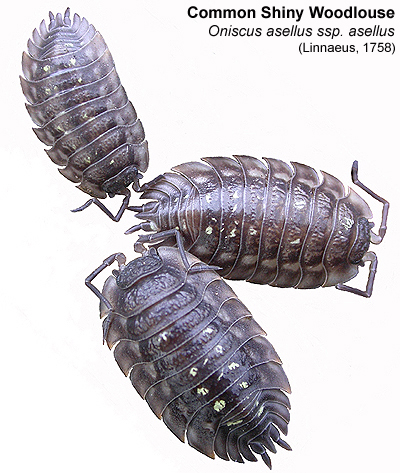 |
|
| .... | ||
| Between them,
Carr and Pearson recorded Armadillidium vulgare
(Common Pill Woodlouse), Oniscus asellus (Common
Shiny Woodlouse), Philoscia muscorum (Common
Striped Woodlouse), Platyarthrus hoffmannseggi
(Ant Woodlouse), Porcellio dilatatus, Porcellio scaber (Common
Rough Woodlouse) Porcellionides pruinosus (Plum
Woodlouse) and Trichoniscus
pusillus (Common Pygmy Woodlouse) in
Nottinghamshire. Several other discoveries followed in the 1960's and 1970's. Most involved very small, soil-dwelling woodlice including Haplophthalmus danicus from near Rufford CP in 1961 (Standen, V.), while Androniscus dentiger, Trichoniscus pygmaeus and Trichoniscoides albidus recorded in the county for the first time from West Bridgford in 1975 (Rundle, A.J.) and Trichoniscus provisorius from Sutton Bonington (Fussey, G.D.) in 1979. The much larger Cylisticus convexus, was recorded from the old Boughton Tip (now known as Ollerton Pit Woods) in 1986 (Langston, M.R.). All five species have been recorded again in the past year or so. Some recent Nottinghamshire additions With presently around 40 known UK species, Woodlice recording and interest has gathered little momentum, although there are several regular Woodlice recorders based around the UK. So if you want to contribute significant and quite unique information on a county level, then an interest in the recording of Isopods (Woodlice) is perhaps the way forward. |
| .... | ||
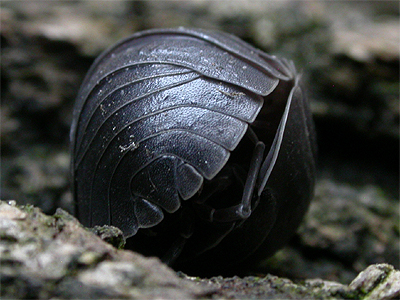 |
On the positive side, there is much to be said in favour of recording Woodlice. As invertebrates go, identification is limited to below 60 species, they can be found in any location type and throughout the year. Only in extremely cold conditions, will they become more difficult to find as they move deeper into the substrate to avoid hard frosts. Until a few years ago, we had done very little work on Woodlice ourselves, but within a few months recorded Armadillidium depressum as new to Nottinghamshire in 2013. In September 2016 we recorded Armadillidium nasatum from Southwell Garden Centre and then later from the site of the former Bilsthorpe Colliery in July 2017. Haplopthalmus mengii was also added to the county list in 2017 and Philoscia affinis in 2020. More species must surely be awaiting discovery. The two species which everyone knows are Oniscus asellus (Common Shiny Woodlouse) and Porcellio scaber (Common Rough Woodlouse). Both species are extremely common in gardens and are good species to learn and get to grips with, as far as Woodlouse identification goes. |
|
| .... | ||
| None of Nottinghamshire's eight historically recorded species seem to have declined in the 100 years since Carr's book was published, which is something that cannot be said for most invertebrate orders. Then again, we have very little information to go on and once again, Carr's book provided us with the only historical information we have and there are few additional modern records aside from our own, but interest is increasing. | ||
| Checklist of Nottinghamshire Woodlice |
| ...... |
| TRICHONISCIDAE Sars, 1899 |
| Androniscus dentiger (Verhoeff, 1908) Rosy Woodlouse |
| Haplophthalmus danicus (Budde-Lund, 1880 |
| Haplophthalmus mengii (Zaddach, 1844) |
| Trichoniscoides albidus (Budde-Lund, 1880) Rough Pygmy Woodlouse |
| Trichoniscus provisorius (Racovitza, 1908) |
| Trichoniscus pusillus (Brandt, 1833) Common Pygmy Woodlouse |
| Trichoniscus pygmaeus (Sars, 1898) Least Pygmy Woodlouse |
| ...... |
| PHILOSCIIDAE Kinahan, 1857 |
| Philoscia affinis Verhoeff, 1908 |
| Philoscia muscorum (Scopoli, 1833) Common Striped Woodlouse |
| ...... |
| PLATYARTHRIDAE |
| Platyarthrus hoffmannseggi (Brandt, 1833) Ant Woodlouse |
| ...... |
| ONISCIDAE Latreille, 1806 |
| Oniscus asellus (Linnaeus, 1758) Common Shiny Woodlouse |
| ...... |
| PORCELLIONIDAE Brandt & Ratzeberg, 1831 |
| Porcellio dilatatus (Brandt, 1833) |
| Porcellio scaber (Latreille, 1804) Common Rough Woodlouse |
| Porcellio spinicornis (Say, 1818) |
| Porcellionides pruinosus (Brandt, 1833) |
| ...... |
| TRACHELIPODIDAE |
| Trachelipus rathkii (Brandt, 1833) |
| ...... |
| CYLISTICIDAE |
| Cylisticus convexus (De Geer, 1778) |
| ...... |
| ARMADILLIDIIDAE Brandt, 1833 |
| Armadillidium depressum (Brandt, 1833) |
| Armadillidium nasatum (Budde-Lund, 1885) |
| Armadillidium vulgare (Latreille, 1804) Common Pill Woodlouse |
| Rosy Woodlouse Androniscus dentiger (Verhoeff,
1908) |
||
| A small Woodlouse found under logs and stones, usually in synanthropic situations such as urban gardens, post-industrial brownfield sites and several former Collieries . Recent surveying has showed this beautiful pink coloured species to be widespread, but thinly scattered across much of western Nottinghamshire. | ||
| .... | ||
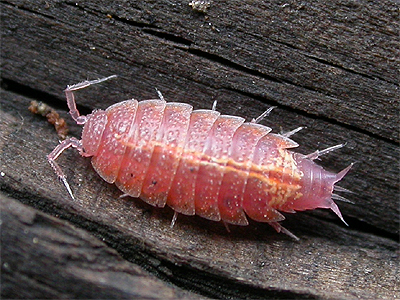 |
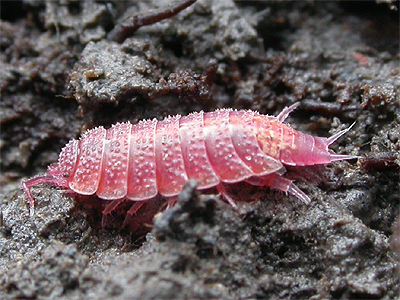 |
|
| Haplophthalmus danicus (Budde-Lund, 1880) |
||
| This is a
tiny cream coloured Woodlouse and one of three extremely
similar Haplophthalmus speciesfound in the UK,
although only two species are known from Nottinghamshire.
Because they are so small (under 4mm) and soil-dwelling ,
there are few Nottinghamshire records, but this Woodlouse
is starting to be found through careful surveying. So far known only from the Sherwood Forest area of Nottinghamshire, Haplophthalmus danicus was first recorded from near Rufford CP in 1961 (Standen, V.). There were no further records until 2017, but it has been found on a number of occasions since, with known sites including Clipstone Old Quarter , Sherwood Forest CP, Cuckney and Cockglode Wood (all Pendleton, T.A. and Pendleton, D.T.). A record from Warsop Main Pit Top in 2017 (Pendleton, T.A. and Pendleton, D.T.) is currently the only county record from a brownfield site. Likely to be more common than records suggest. |
||
| .... | ||
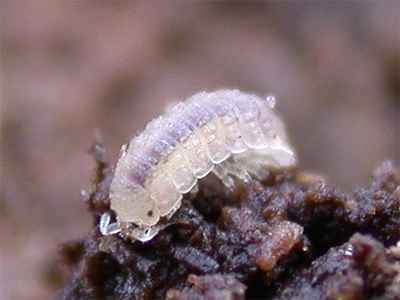 |
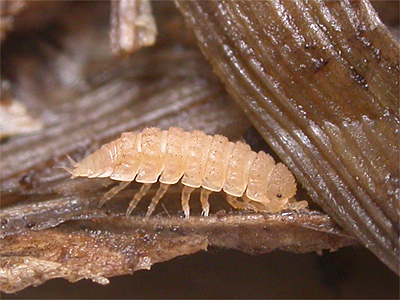 |
|
| Haplophthalmus mengii (Zaddach, 1844) |
||
| Another tiny subterranean Woodlouse, which seems to have been unknown from Nottinghamshire, until a single specimen was found at Ransom Wood in August 2017 (Pendleton, T .A. and Pendleton, D.T.). It has since been recorded at Clipstone Old Quarter in Sherwood Forest (Pendleton, T.A. and Pendleton, D.T.) in October 2017 and then at both Attenborough NR (Sexton, T.) and Warsop Main Pit Top (Pendleton, T .A. and Pendleton, D.T.) in early and late 2018 respectively. Almost certainly a good deal more common than the current lack of records would suggest. All specimens have been found underneath partly buried logs or stones. | ||
| .... | ||
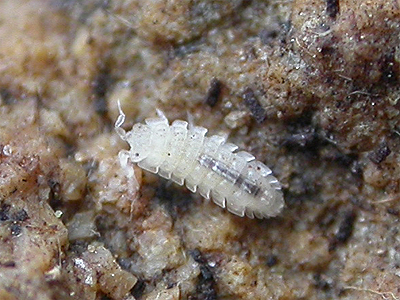 |
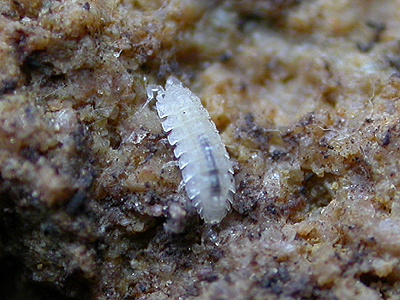 |
|
| Rough Pygmy Woodlouse Trichoniscoides albidus (Budde-Lund, 1880) |
||
| A small
reddish-brown Woodlouse, similar in appearance to Trichoniscus
pusillus and usually found under stones in wet/damp
locations. Recent
research has discovered that Trichoniscoides albidus
was originally found new to Nottinghamshire in 1975, when
recorded from West Bridgford (Rundle, A.J.). This was found to precede records from two
sites along the River Trent at Farndon near Newark (Whiteley, D.) in January 2016, which at the time were thought to represent
the first records for the Nottinghamshire. It was
subsequently found in flood debris along the bank of the
River Trent at Stoke Bardolph in February 2017 (Pendleton , T.A. and Pendleton,
D.T.).
Probably more widespread along many of the county's rivers, than present records would suggest, but especially likely to occur along other stretches of the Trent Valley. |
||
| .... | ||
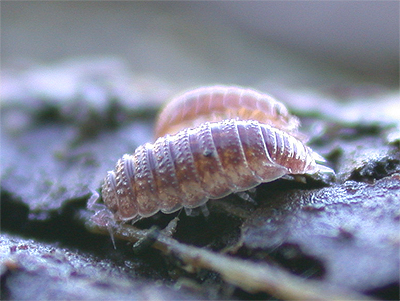 |
||
| Trichoniscus
provisorius (Racovitza, 1908) |
||
| Almost
certainly as common and widespread as the visually
identical Trichoniscus pusillus, but because of
the identification difficulties, the male needs examining
under a microscope to identify to species level. Found
under stones, logs and other debris in a range of
habitats, including gardens. Once considered to be a form of Trichoniscus pusillus Brandt, 1833, Trichoniscus provisorius was given full species status a number of years ago. But because of the difficulties in identification, the only county records are from Sutton Bonington in 1979 (Fussey, G.D.) and Sherwood Forest CP in February 2018 (Pendleton, T .A. and Pendleton, D.T.). |
||
| .... | ||
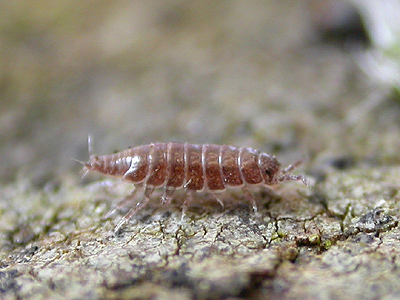 |
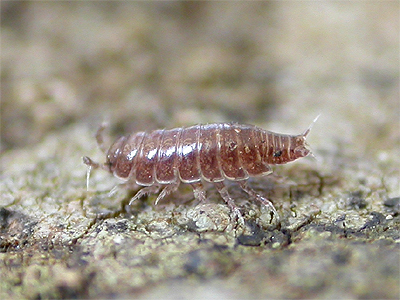 |
|
| Common Pygmy Woodlouse Trichoniscus pusillus (Brandt, 1833) |
||
| An extremely common, very small Woodlouse, with a length of just 4mm at maximum and coloured reddish/purple. It is found under logs in most damp habitats, but because of the visually identical Trichoniscus provisorius, the male needs examining under a microscope to identify for certain. | ||
| .... | ||
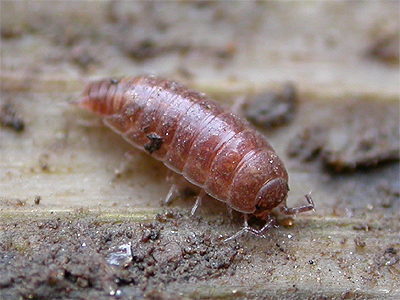 |
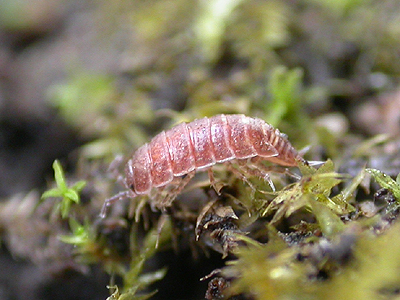 |
|
| Least
Pygmy Woodlouse Trichoniscus pygmaeus (Sars, 1898) |
||
| Another very small, soil-dwelling Woodlouse, characterised by having a pale pink, or yellowish colouration, with an almost white head. To date, Trichoniscus pygmaeus has proved to be a rare species to find, with the first Nottinghamshire record being from West Bridgford in 1975 (Rundle , A.J.). There were no other records until single specimens were found underneath a piece of wood buried under leaves at Market Warsop (in company with Androniscus dentiger) and at Cockglode Wood in 2018 (Pendleton, T.A. and Pendleton, D.T.), this time found with numbers of Haplophthalmus danicus. Likely to be a much under-recorded species. | ||
| .... | ||
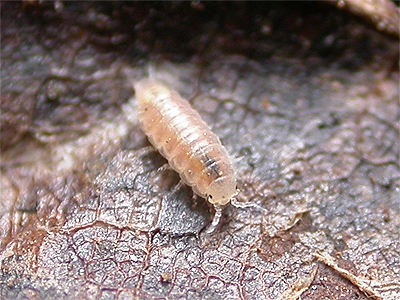 |
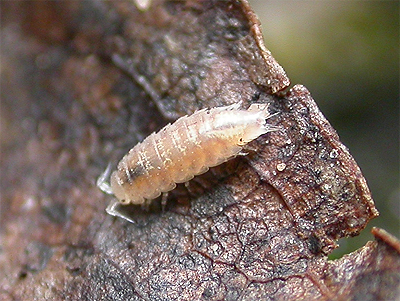 |
|
| Philoscia affinis
Verhoeff, 1908 |
||
| Currently only known from a single Nottinghamshire site located in light riverside woodland at Meden Vale, where it was recorded on two occasions from samples of leaf litter and bark chippings in 2022 and from the Sherwood Forest CP, where it was finally found in a leaf litter sample in early 2023 (Pendleton, T.A.) after several years of searching. It favours the same habitat as Philoscia muscorum and it is extremely similar, so identification ideally requires microscopic examination of a male specimen. | ||
| .... | ||
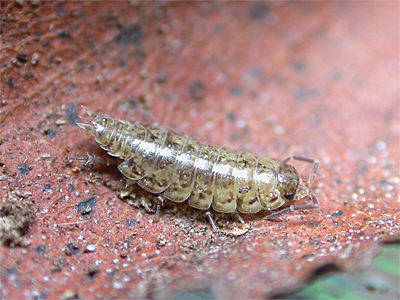 |
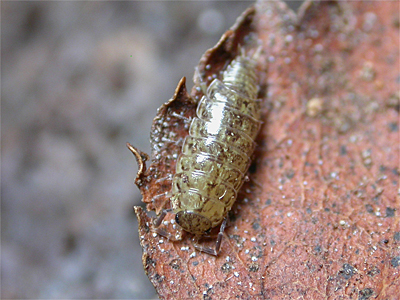 |
|
| Common Striped Woodlouse Philoscia muscorum (Scopoli,
1833) |
||
| A common, fast moving and well marked Woodlouse, Philoscia muscorum is usually found in well vegetated, grassy sites, but seems to be very common in most of the county's woodlands. It regularly occurs in suburban parks and gardens. | ||
| .... | ||
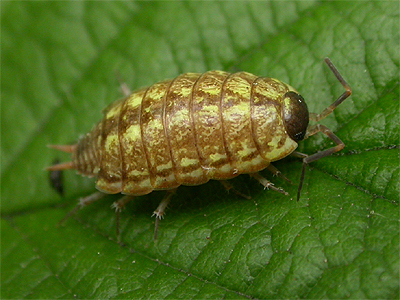 |
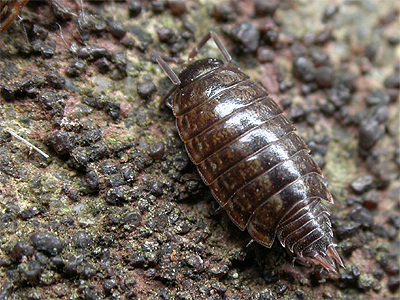 |
|
| Ant Woodlouse Platyarthrus
hoffmannseggi (Brandt, 1833) |
||
| A small, pure white 3-4mm long Woodlouse, spending its entire life underground. It is commonly found inside the nests of various species of ants including Lasius niger, Lasius flavus and Myrmica rubra. This is one of the easiest Woodlice to record, as there are no identification difficulties and it is certainly much more widespread than the distribution map would suggest. There are large areas of the county still awaiting records. | ||
| .... | ||
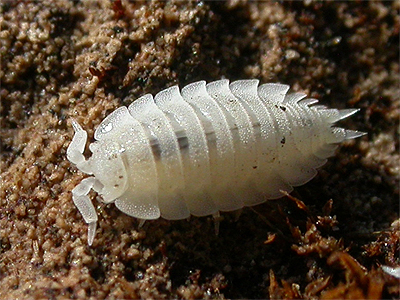 |
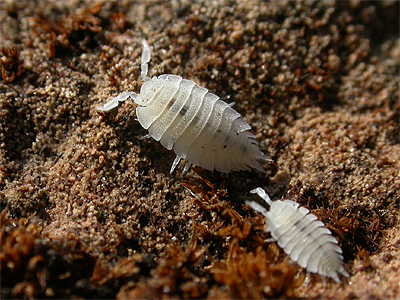 |
|
| Common Shiny Woodlouse Oniscus
asellus ssp. asellus (Linnaeus, 1758) |
||
| A very common Woodlouse, which is probably present in every single km square in Nottinghamshire. It is found in all habitats including urban gardens and is one of our most familiar species. | ||
| .... | ||
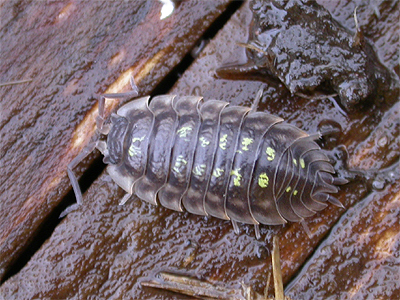 |
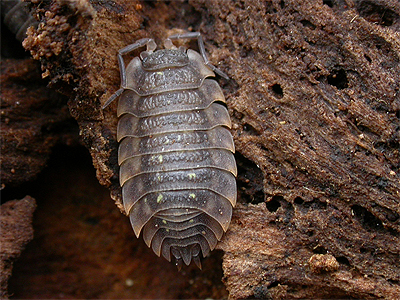 |
|
| Porcellio
dilatatus
(Brandt, 1833) |
||
| Nationally described as rare, Porcellio dilatatus is a Woodlouse of synanthropic sites and often found on, or around farms. In Nottinghamshire, the only historical record was from a Chilwell greenhouse in the early 1900's. There were no subsequent records, until it was found in an old milking shed at a former Lambley farm in January 2016 (Pendleton, T.A. and Pendleton, D.T.). Despite seemingly being so rare in the county, it is likely to be present at other Nottinghamshire farms . | ||
| .... | ||
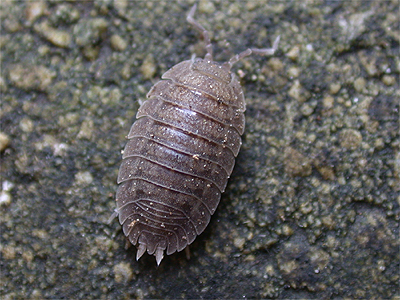 |
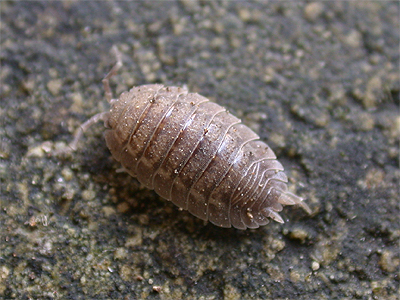 |
|
| Common Rough Woodlouse Porcellio scaber (Latreille,
1804) |
||
| An extremely common Woodlouse, often showing some striking variations in colour. Another very widespread species, abundantly common in all habitat types throughout Nottinghamshire. It is regularly found under logs and stones etc, often in large numbers and is one of the two large Woodlice commonly found in any garden. | ||
| .... | ||
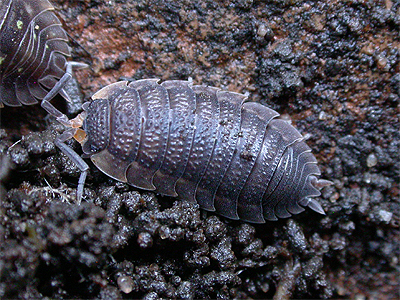 |
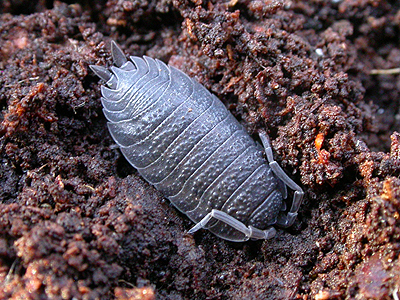 |
|
| Painted
Woodlouse Porcellio
spinicornis (Say, 1818) |
||
| A common and well distributed Woodlouse over most of the UK, Porcellio spinicornis can be common underneath the loose mortar of old stone walls. Since 2015, several targeted surveys have showed that this species is relatively widespread in Nottinghamshire, with records from Cuckney, Edwinstowe, Sookholme and Lowdham Churches, Worksop Priory, the old kitchen garden at Nettleworth Manor and Arnot Hill Park. Yet until recently, the only county record was from West Bridgford in 1975 (Holdich, D.M). | ||
| .... | ||
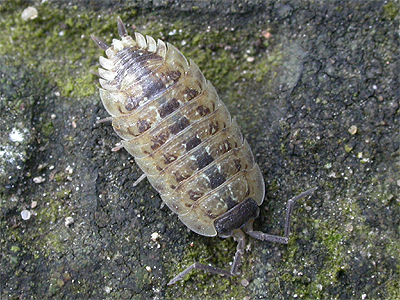 |
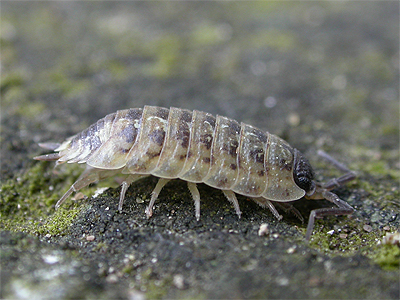 |
|
| Plum
Woodlouse Porcellionides
pruinosus
(Brandt,
1833) |
||
| A common and
well distributed Woodlouse over most of the UK. It is
without doubt , considerably under-recorded in
Nottinghamshire. Despite the scarcity of county records, Porcellionides
pruinosus is likely to be encountered within the
manure heaps of most Nottinghamshire farms, but it has
occurred within the grounds of two sites with no obvious
links to manure. Recent records have come from the grounds of Hawton Church (Whiteley, D.) and Epperstone Church (Pendleton, T.A. and Pendleton, D.T.). One was also found under the loose bark of a cut branch on The Carrs at Market Warsop (Pendleton, T.A. and Pendleton , D.T.), a few months after adjacent fields had had manure spread on them. Records from more typical habitat have been from manure heaps at Tug Bridge Farm near Eakring (Pendleton, T.A. and Pendleton, D.T.) and the Nottingham Trent University's Brackenhurst Campus near Southwell (Heeney, W. and Skinner, M. Lugg, K. and Lugg, B.) in 2015, and from a former farm Lambley in early 2016 (Pendleton, T.A. and Pendleton, D.T.). |
||
| .... | ||
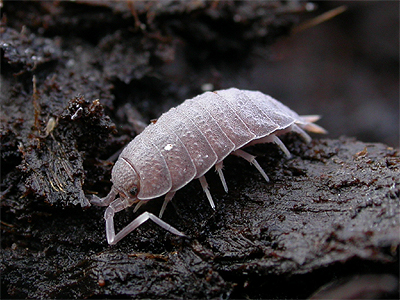 |
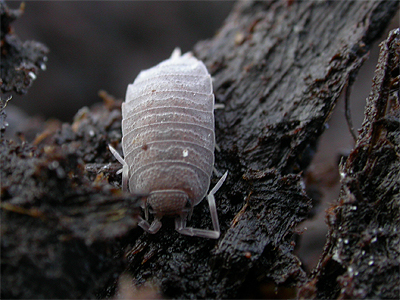 |
|
|
Trachelipus rathkii
(Brandt, 1833) |
||
| New to Nottinghamshire in March 2021, when found at Stoke Bardolph (Pendleton, T.A.). Always found near to water Trachelipus rathkii occurs under stones and other long standing flood debris. Nottinghamshire's first were located under the loose bark of some felled trees in a disused car park near Burton Joyce, but more turned up under an old rabbit hutch door and then underneath stones on the bank of the River Trent. The site had recently been under water, following the Trent bursting its banks earlier in the year. This Woodlouse should be expected at other sites locally, especially along southern reaches of the River Trent, under logs or stones which are prone to flooding. | ||
| .... | ||
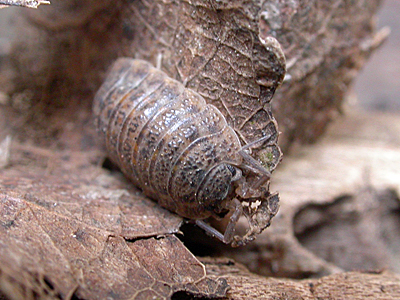 |
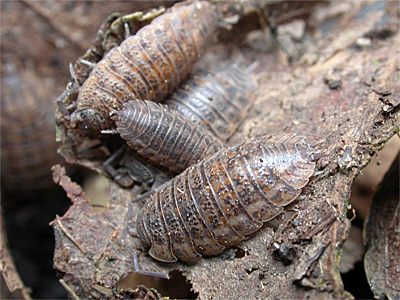 |
|
| Cylisticus
convexus
(De Geer, 1778) |
||
| Only recorded in Nottinghamshire on two occasions. Both records are from two former Colliery sites, with a record from the old Boughton Tip (now known as Ollerton Pit Woods) in August 1986 (Langston, M.R.) and from the former Warsop Main Pit Top in November 2018 (Pendleton, T.A. and Pendleton, D.T.). Almost certainly under-recorded in the county. | ||
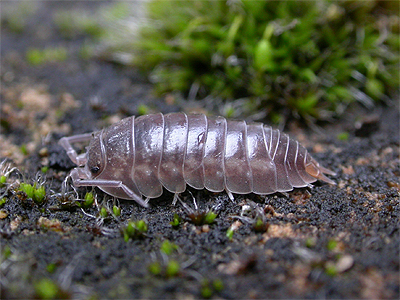 |
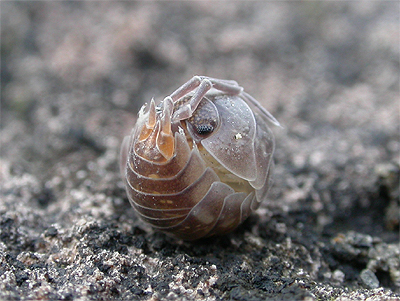 |
|
| Armadillidium
depressum
(Brandt,
1833) |
||
| This large Woodlouse rolls into a slightly open ball when threatened. This characteristic is a useful technique to help towards determining the species, but should not be used alone in confirming identification. Generally a Woodlouse of south-west parts of the UK, Armadillidium depressum was a surprise find on the stone wall of Carr Bank Park in Mansfield in 2013 (Pendleton, T.A. and Pendleton, D.T.), when found tucked into a small eroded piece of stonework and measured 18mm in length. It has been recorded from the same location since, but there was a surprising record from Mapperley in 2016 (Pendleton, T.A. and Pendleton, D.T.). | ||
| .... | ||
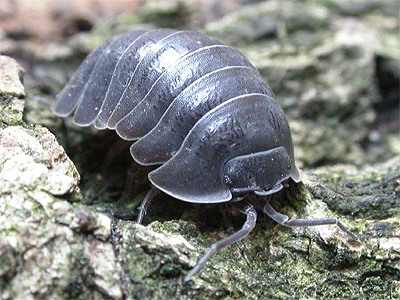 |
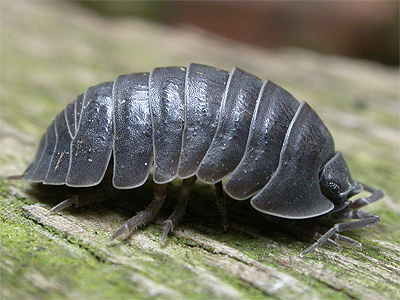 |
|
| Armadillidium
nasatum
(Budde-Lund, 1885) |
||
| A distinctive
Woodlouse, often recorded from old quarries, garden
centres and brownfield sites. Armadillidium nasatum
had been well recorded in Leicestershire for a number of
years (Daws, J.), before several specimens were
discovered at the Southwell Garden Centre in September
2016 (Pendleton, T.A.
and Pendleton, D.T.). It has since turned up at two other sites, with an obviously long established population found to be present on the site of the former Bilsthorpe Colliery in 2017 (Pendleton, T.A. and Pendleton, D.T.). In November 2018, it was found on the site of the former Warsop Main Colliery at Warsop Vale (Pendleton, T.A. and Pendleton , D.T.). This record surprised us to a large degree, as the site had been well recorded for a number of years, but A. nasatum is likely to be found at many other former Colliery sites in Nottinghamshire, especially where conditions are dry and stony. |
||
| .... | ||
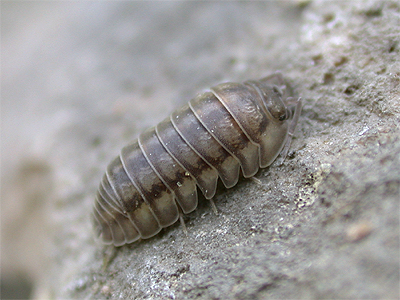 |
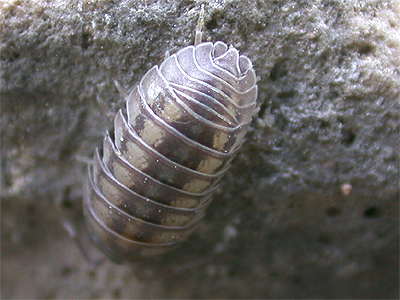 |
|
| Common Pill Woodlouse Armadillidium vulgare (Latreille,
1804) |
||
| A common Pill Woodlouse usually found under logs or stones and one which regular recording has showed to be widespread in the county. It can often be found in numbers, usually in company with Oniscus asellus and Porcellio scaber. Armadillidium vulgare rolls into a complete, enclosed ball in defence. | ||
| .... | ||
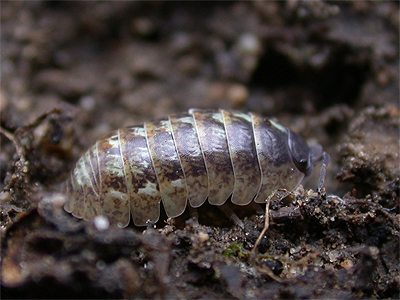 |
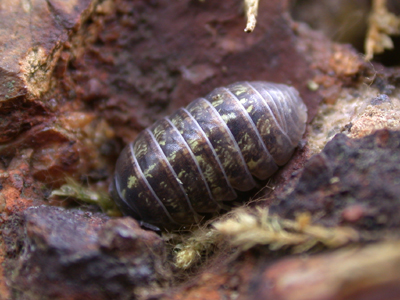 |
|